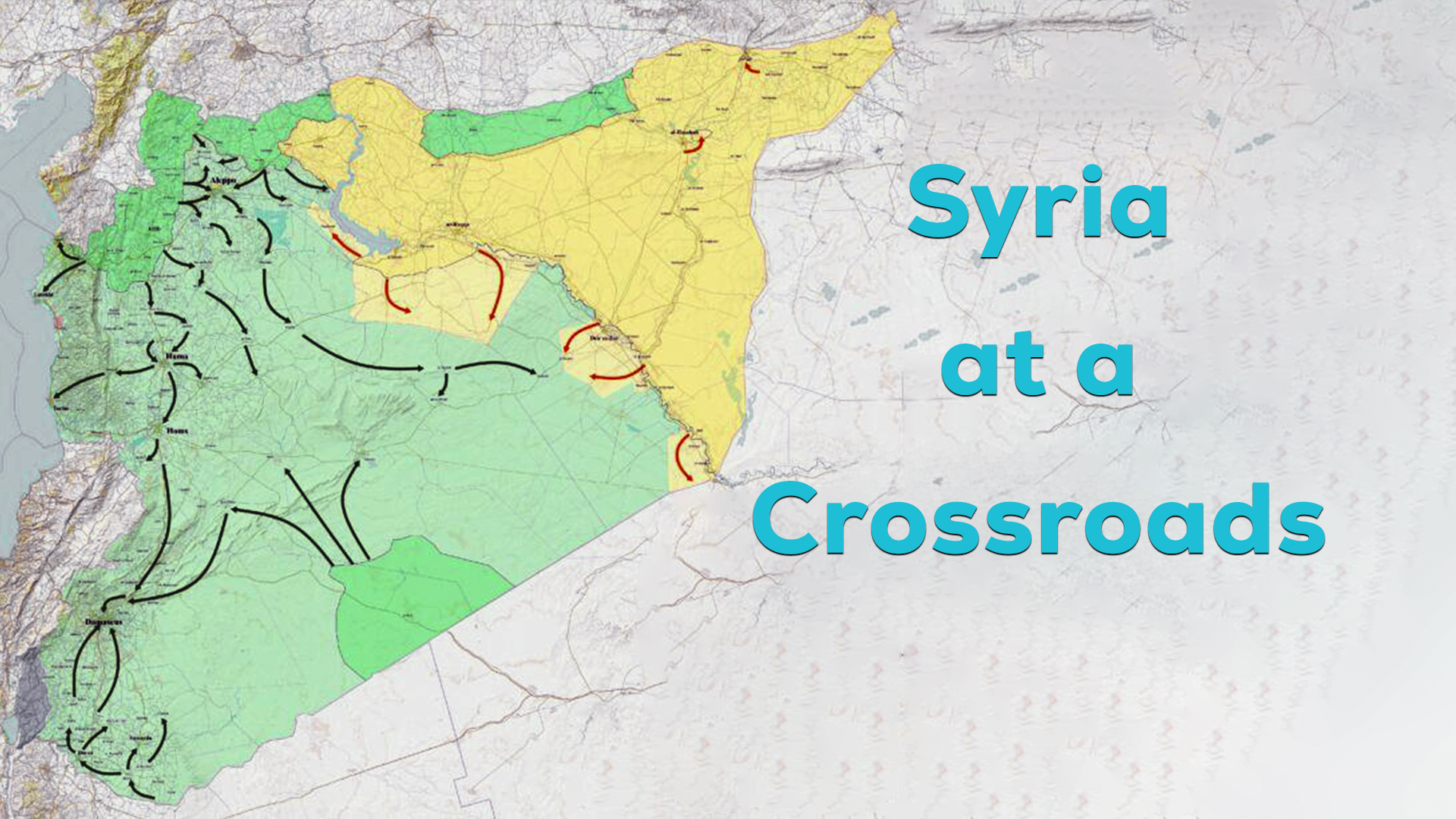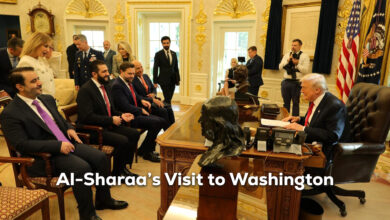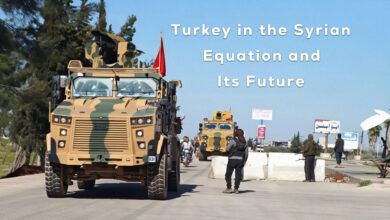Syria at a Crossroads

Following the seizure of power in Damascus by Hayat Tahrir al-Sham (HTS) and the appointment of Ahmad al-Shara’a as interim president of the Syrian Republic, the interim government (the Salvation Government) imposed a policy of exclusion and a one-party approach on Syrian society. It seized control of the executive and judicial authorities in Syria and is currently working to extend its influence over the legislative authority by holding parliamentary elections tailored to its interests. This extends beyond the appointment of one-third of the parliament’s members by the interim president, as it also involves controlling the criteria for candidate selection. This effectively gives HTS control over the entire People’s Council and excludes three governorates—Hasakah, Raqqa, and Suwayda—from the electoral process.
In addition, the al-Sharaa family has consolidated control over the Syrian economy through the establishment of sovereign funds. The massacres committed against Syria’s Alawite and Druze communities have fueled demands from the Druze for independence from Damascus or for autonomous governance within a federal Syria, alongside the creation of a military force (the National Guard). Similarly, the Alawites abroad have established a political council for central and western Syria within a federal framework.
Meanwhile, the Democratic Autonomous Administration of North and East Syria (AANES) and the Syrian Democratic Forces (SDF)—born out of the Syrian crisis—have fought terrorist groups, primarily ISIS, liberated eastern Euphrates territories from these extremist factions, and established a democratic system within their regions. Their governance model has become an example for all Syrian areas and communities, demonstrating a system in which every community enjoys rights within a federal structure.
This role played by the AANES is viewed as a threat by the new Syrian regime. Damascus perceives it as diminishing its authority, while Turkish pressures further prevent a political agreement from being reached. Consequently, the transitional government has begun evading its responsibilities and obstructing the implementation of the March 10 agreement between al-Sharaa and Mazloum Abdi. At the same time, the interim government accuses the SDF and the AANES of hindering the agreement, despite repeated shuttle visits by AANES leaders to Damascus aimed at reducing tensions, preventing a major internal crisis, and advancing negotiations toward an agreement that could end the chaos and division in Syria.
Reasons Behind the Stalled Negotiations Between the Two Sides
Negotiations between the AANES and the new Syrian regime are inherently difficult to reach a final agreement due to regional and international interventions affecting the negotiation process, as well as fundamental differences between the two sides’ political projects. The main reasons for the deadlock include:
- Turkish Influence on the Syrian Regime: The new Syrian regime is unable to break free from Turkish dominance or make any independent political decisions—particularly regarding negotiations with the SDF or the shape of Syria’s governance—without receiving Ankara’s green light. The shuttle visits between the two parties whenever political developments occur at the Syrian, regional, or international level indicate the clear pressure Turkey exerts. Conversely, Israeli pressures can counterbalance Turkish demands when they exceed the regime’s capacity to implement them. For example, the Suwayda region, which is rapidly moving toward self-administration and federal demands, cannot face a military campaign by Damascus due to Israeli deterrence, even though Turkey pressures the regime to prevent a federal-style autonomous administration there.
- Domestic Policy of the New Regime: The regime’s Salafi-jihadist mindset toward Syria’s minority communities—the Alawites, Druze, and Kurds—and its rejection of their role in building a democratic Syria is evident. This was reflected in the National Congress and the constitutional declaration, which excluded these communities, and in the regime’s refusal to convene an inclusive national conference. The regime preemptively accused these groups of separatism or loyalty to remnants of the former regime and committed massacres against non-Sunni communities, including the Alawites, Druze, and Kurds.
- Fundamental Project Divergence: There is a major contradiction between the two sides: the AANES advocates a decentralized democratic system, while the new regime seeks a centralized, dictatorial system resembling the previous regime, making negotiations highly challenging.
- Insistence on Centralization: The new regime views any proposal deviating from centralization as an attempt at secession from Damascus. It ignores the failures of centralized rule over the past half-century and the societal impact of the Syrian crisis. This insistence is bolstered by Turkish and some Arab states’ support, obstructing successful negotiations.
- Time-Gaining Tactics: The Syrian regime seeks to buy time, either to establish a parallel military force to the SDF to shift the balance of power, await outcomes from negotiations with Israel, or prepare for a U.S. withdrawal from the eastern Euphrates to launch a military operation.
- SDF’s Conditions for Integration: The SDF insists on joining the new Syrian army as an independent military bloc. The SDF has reservations about the army’s structure, which includes individuals designated as terrorists with a record of violations against Kurds and Arabs in Tel Abyad, Ras al-Ain, and Afrin, such as Mohammad Hussein al-Jassem (Abu Amsha), leader of the Suleiman Shah Brigade, and Ahmad al-Hayes (Abu Hatim Shaqra), leader of the Ahrar al-Sharqiya Brigade. Despite partial integration, these factions retained their military structures, as seen in massacres in the coast and Suwayda.
- AANES’s Commitment to Decentralization: The AANES maintains that the centralized system has failed over more than half a century. A decentralized system ensures the rights of all Syrian communities. The AANES, born out of the Syrian crisis, has demonstrated the success of its democratic model.
In addition, numerous cultural, social, and political issues remain unresolved between the two sides.
The Role of External Parties
The role of countries involved in Syria cannot be ignored, as they exert significant influence over events on the ground. These countries wield considerable power over the new regime in Damascus and possess the capacity to alter the rules of the game in Syria. Each country follows a distinct strategy, which affects the trajectory of the Syrian crisis and the course of negotiations.
Turkey
Turkey plays a central role in prolonging the Syrian crisis and undermining negotiations between the two sides. Ankara firmly rejects any national dialogue that could transform the current centralized system into a federal or decentralized model. Turkey aims to dismantle the AANES and the SDF by integrating them into the new Syrian army as individuals rather than as an independent military bloc. Turkey’s agenda is to keep Syria unstable to serve its strategic interests and neo-Ottoman ambitions.
Although Turkey has failed to obtain U.S. approval for a large-scale military operation against AANES-controlled areas, it is relying on the new Syrian regime to carry out such operations with Turkish military support should Syria move toward a federal system. Turkey’s main objective is to dismantle the AANES and the SDF under the pretext that they pose a threat to its national security, even if other regions gain autonomous governance. Practically speaking, northern Syria is already under Turkish oversight, with no authority from Damascus, administered by Turkish-backed militias such as the Amshat, Hamzat, and Ahrar al-Sharqiya factions, collectively known as the National Army, despite their nominal integration into the new Syrian army.
Even though Suwayda has demanded not only federalism but also potential separation from Damascus, Turkey cannot threaten the region due to Israeli protection. However, Turkey may launch military operations against DAA-controlled areas through its proxies, as the AANES represents the primary force and the standard-bearer of democracy in Syria. Turkey’s role is well-established: it obstructs any national dialogue between Damascus and the AANES and will not allow the new regime to sign any agreement with the SDF or the AANES that could advance Syria toward a democratic system. Following Assad’s potential fall, Turkey seeks to dominate Syria but faces opposition from Israel, which resists any expansion of Turkish influence.
The United States of America
As a leading military power in the international coalition against ISIS, the United States does not directly intervene in negotiations. Its role, aside from combating ISIS, is limited to preventing armed conflict in the eastern Euphrates that could compromise the SDF’s anti-ISIS operations. Politically, however, the United States possesses sufficient political, military, and economic leverage to play a pivotal role in facilitating negotiations, reconciling differing positions, and curbing regional influence that might derail the peace process or Syria’s path toward democracy. Nonetheless, through its envoy Thomas Barrack, the U.S. may pursue a specific policy toward the new regime and Syria’s governance structure, guided by its broader strategic interests in the Middle East.
Israel
Israel has its own strategic calculations; however, broadly speaking, it is part of the “New Middle East” project. Israel took advantage of the HTS’s control over Damascus to expand into southern Syria and secure strategic areas. It is currently working to make southern Syria a fully demilitarized zone and to prevent further Turkish influence in Syria, which it perceives as a threat to its national security. Although Turkey and Israel are partners and allies, bound by economic, military, and security relations, each pursues a different strategy, resulting in competition and conflict over influence within Syria.
Russia
Russia’s position is no longer what it once was; it has lost much of its influence in Syria. Nevertheless, it still retains leverage it can use to pressure the new Syrian regime in order to maintain its military bases in the region. Russia also plays a role that aligns with Israeli and even U.S. interests in Syria, acting either as a buffer between the new Damascus regime and Israel in southern Syria or as a force to prevent Turkish expansion along the Syrian coast.
The Future of Negotiations Between the Two Parties
The March 10 agreement between Ahmad al-Sharaa and Mazloum Abdi provides a fundamental framework that could facilitate successful negotiations, alongside shuttle visits by the AANES to Damascus aimed at bridging the gap and reaching a comprehensive agreement to resolve the Syrian crisis. However, the mentality of the new Syrian regime, coupled with Turkish pressures, indicates that the two sides are unlikely to reach a joint agreement, despite the significant efforts of the AANES and the SDF to reconcile differences.
It is not surprising that the new regime, with the backing of Turkey, may attempt to buy time to consolidate its position, prepare militarily, and create favorable conditions for attacking the SDF and asserting control over the AANES areas under the banner of the “Arab Tribes Forces” (Al-Faz’a al-Arabiya). The regime claims these are rogue groups beyond Damascus’s authority; however, both the new regime and Turkey are aware of the SDF’s strength and recognize that such an operation could result in a major defeat that might end the regime’s authority in Damascus. Additionally, internal conditions are currently unfavorable for such an operation, especially given that the Druze community is demanding a federal system and has established a military force (the National Guard), while the Alawite community has announced the formation of a political council for central and western Syria.
Where Are Events Headed?
Negotiations between the two parties are ongoing; however, they have yet to achieve any breakthrough in bridging the divide between them. Based on indicators related to the negotiations, Turkish pressures on the new Syrian regime, the mentality of this regime, the massacres committed against the Alawite and Druze communities, and recent statements—most notably by the leader of the Turkish nationalist party, Devlet Bahçeli, who threatened military intervention against the SDF and incited sectarian mobilization against them—there are clear warning signs. These threats were met by a response from SDF commander Mazloum Abdi, who confirmed the SDF’s readiness for any military eventuality while maintaining commitment to dialogue and politics, advocating for a new decentralized Syria.
These indicators suggest that the negotiations may merely serve as a delaying tactic by the new regime and its regional backers, such as Turkey and Qatar, to prepare for a brutal military operation against AANES areas and the SDF, unless the latter relinquish all their democratic demands. One key question arises: why have negotiations not yet been conducted at the leadership level by the new regime? This raises doubts about the regime’s seriousness in pursuing genuine negotiations.
A potential military operation could begin in the Sheikh Maqsoud and Ashrafiyah neighborhoods to seize full control of Aleppo. The regime may also attempt to capture Deir Hafer to cut supply routes to Aleppo. From Sheikh Maqsoud and Ashrafiyah, the conflict could expand along the Euphrates River and toward the occupied fronts of Tel Abyad (Kobani) and Ras al-Ain (Serê Kaniyê), controlled by Turkish-backed mercenary factions, potentially plunging Syria into a new cycle of internal conflict.
Potential Outcomes of a Military Operation
Those who destroy cannot build; those who commit massacres—through killing, rape, looting, and sabotage—cannot reconstruct Syria. The current threats, violations, and incitement suggest that the region is heading toward significant events, which could surpass the scale of past incidents in the Syrian coast and Suwayda, potentially altering the domestic situation in Syria and fundamentally changing the balance of power. However, a major obstacle for Turkey, its mercenaries, and the new Damascus regime is the U.S. presence in eastern Syria.
Should such an operation occur in AANES areas, its consequences would differ drastically from those in the coast and Suwayda. Unlike the geographically limited past events, an operation against the AANES areas could affect vast regions of Syria due to the spread of democratic ideals among Syrian communities, particularly in the coast and south, and the presence of Kurds in major cities with cross-border ties in Turkey and Iraq. This, combined with strong national and emotional sentiments among Kurds, could trigger mobilization across all of Kurdistan and in the diaspora, especially in Europe, where “Rojava” holds deep symbolic significance. Turkish involvement could destabilize the peace process within Turkey itself, potentially reigniting armed conflict there on an unprecedented scale.
Arab tribes aligned with the AANES and SDF would play a crucial role in confronting both terrorist factions and Turkish-backed mercenaries, as well as some pro-regime tribes, who have a documented history of violations including killing, enslavement, rape, and looting. The loyalty of indigenous Arab tribes to their local administration and the SDF has been repeatedly demonstrated during the early stages of the Syrian crisis, including the rise of the Free Syrian Army, Jabhat al-Nusra, ISIS, and atrocities committed in Tel Abyad, Ras al-Ain, and Manbij against Arab populations.
While such an operation could have severe economic and social consequences for Syria and risk reviving ISIS through regional actors, it may ultimately determine the country’s future: either a centralized, dictatorial state with an exclusionary extremist ideology or a federal state in which all ethnicities, communities, and sects enjoy constitutional rights under a democratic system. Although the AANES and SDF could sustain significant damage, the ultimate losers would likely be Turkey and the Syrian regime, as the operation would have domestic, regional, and international ramifications.
Thus, due to Turkey’s substantial influence in northern Syria, the pressures it exerts on the new Syrian regime, the regime’s alignment with Turkish agendas and inability to make independent political decisions, the systematic incitement by the regime against the AANES and SDF, and manipulation of Arab tribal dynamics, coupled with the lack of any breakthrough in negotiations capable of easing internal tensions and preventing a civil war, and if regional powers continue to interfere in Syria’s internal affairs while major powers fail to pressure the regime to implement UN Resolution 2254, Syria appears poised, by 2026 at the latest, for major events and repercussions that will not be confined to the domestic arena but will extend across borders.




